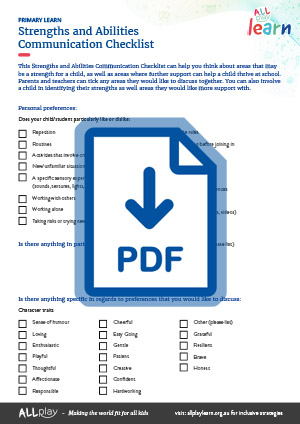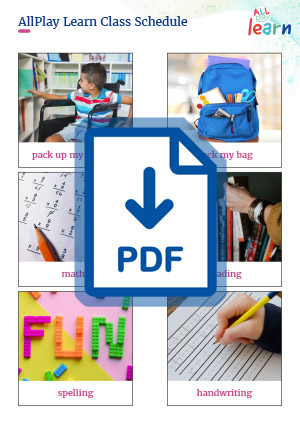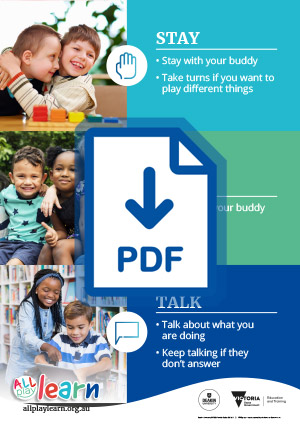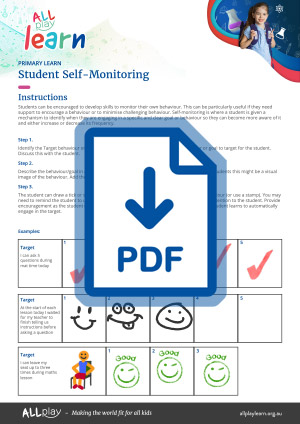
Speech, Language and Communication Needs
On this page:

About speech, language and communication needs
‘Communication’ is the exchange of both verbal and nonverbal information. It includes talking, as well as the understanding of words, visual information, body language, facial expressions, and gestures (e.g. pointing, waving hello, nodding your head to mean “yes”).
Some students may need support with communication. Each child will have their own profile which may change over development. Some children may have difficulty producing sounds and words (e.g. stuttering or mutism), and they may use visual aspects of communication instead (e.g. gestures, eye contact or picture cards). Other students may find understanding visual communication challenging.
Some students may need support with using and understanding spoken language. A student’s ability to understand spoken language may be different from their ability to use spoken language. For example, a student might be able talk and express themselves clearly, but they may find it harder to understand instructions, especially if they are long or complex.
Some students may require support with using verbal and nonverbal communication in social situations. For example, some students may have trouble understanding the meaning behind greetings (e.g. saying hello, shaking hands) or taking turns in conversations. Other students may not understand humour and jokes, or metaphors.

Strengths
What might be some strengths?
- Some students with communication needs participate successfully in learning when given clear and specific instructions.
- Some children may have good visual perceptual skills. They may be good at visual searches and recognition.
Where might you provide support?
- Some students may be reluctant to participate in classroom activities and discussions where language is used.
- Some may have difficulties with interacting with other students and making friends.
- Some children may find it hard to express how they feel. This can cause frustration and challenging behaviours.
- Some students may be easily distracted and find it challenging to focus on activities.

Evidence-based strategies
Work Collaboratively
Consider how you give instructions and communicate
Provide feedback
Teach students learning strategies
Create an environment supportive to language development
- Get more information. Talk to the student, their family and support team to find the best methods of communication and support. They can help you understand the student’s unique strengths, preferences, and the areas they may require support.
- Build a relationship with other professionals involved. Working together can lead to a shared understanding of the student and consistent goals and strategies used across school and other environments like home and the community.
- Give simple, specific and direct instructions. This might allow the child to be a bit clearer about the learning tasks. It can also help to demonstrate/model the task or behaviour, or ask another student to demonstrate.
- Use different modes to give instructions and communicate. Visual aids, such as picture cards, can be used in addition to verbal instructions to show a task sequence or a key learning concept. Other options include captioned videos to teach a skill or play activity, or using gestures while giving instructions.
- Provide feedback. Immediate verbal correction if a child mispronounces words or sentences can help them with language if this is done in a way that does not cause embarrassment.
- Consider repeating what the child has said, with the correct word or sentence structure, in a question format.
- Another option is to give the student choices between the incorrect and correct variations to help them process what is being said.
- Teach students how to create their own learning material. Learning how to take notes and create graphic organisers can help students understand and make connections between main points. For example, students could develop a list of the key concepts and vocabulary items relevant to the curriculum.
- Encourage verbal rehearsal. This can be through repeating information mentally or out aloud.
- Model and prompt language use. Use the student’s interests as an opportunity to model and prompt the use of language in day-to-day scenarios and situations. Aim to model words and sentences several times and with a range of visual stimuli. Encourage the child to repeat the sentence or word as needed.
- Pause and expand. Pause to allow students to initiate a topic which is of interest to them. Ask open-ended questions about this topic. Provide children support to construct and expand on responses.
- When reading stories together, promote the student’s interaction. Have conversations with students about books they read. Ask questions while reading, providing students assistance and scaffolding to respond. For example, consider asking students to predict the emotions and actions of characters, or to retell the content of the story. If appropriate, consider playing with toys which match the theme of the book and include the target vocabulary.
- Be responsive. Follow the lead of children, providing responses immediately. If needed, provide feedback. See Provide feedback.

Best practice tips
Create a safe, supportive, and responsive environment
Set clear rules and expectations
Remove distractions
Consider using slower speech
Be patient
Encourage positive role-models
Consider pairing the student with a buddy
Teach meta-cognitive strategies
Teach social skills
Facilitate the use of AAC systems
Promote self-determination
- You can help support student learning and participation by creating a secure and positive social environment where they can build friendships with staff and other students.
- Arrange the environment to encourage independence and allow children to communicate requests. Respond to all attempts at communication children make. See Create an environment supportive to language development (be responsive).
- This will allow the student to know what is expected from them in the classroom.
- Some students might be easily distracted by lights, sounds and objects both inside and outside the classroom environment.
- Consider sitting the student away from, or with their back to, the windows.
- Small group work may also help with reducing distractions, as may keeping desks uncluttered.
- This can help a student listen to and process instructions.
- Try not to rush or interrupt a child when they are trying to speak or communicate. Instead, allow extra time for them to speak and respond.
- Supporting a child with a communication challenge can at times be difficult, and you may feel frustrated. Being aware of your feelings and thoughts is important for a calm and supportive relationship with a child.
- Encouraging other children for positive behaviours (e.g. hands up before speaking, sharing) helps a child to see what is expected. This may encourage them to imitate these behaviours.
- If a student becomes easily distracted during learning activities, consider sitting the student with a peer who can help keep them on track with tasks. A peer can also model tasks or repeat instructions.
- Teach children to use mental imagery. Transforming spoken information into visual images can help reduce the burden on their working memory, and help them understand and remember discourse better.
- Building the social skills of children can facilitate their communicative participation. For example, you might teach children to consider other people’s feelings, be kind, and share. Similarly, teaching children conversational skills, such as asking questions and sharing important information, can facilitate their social interaction with others.
- Unaided AAC systems (e.g., signing, vocalisation, facial expressions) and low-tech AAC systems (e.g., picture communication boards and books, visual schedules) can be beneficial in helping children express themselves. Make sure that the environment is arranged to facilitate children's communication with these systems. For example, check that the AAC system is placed where children can see and access. Add key vocabulary to their AAC system specific to your curriculum (where appropriate). For example, vocabulary related to a new topic could be introduced. You might also consider additional training on using the relevant AAC systems and collaboration with other professionals and families.
- Promote self-determination. Empower and teach children to make simple choices, set goals, be independent, and develop problem-solving abilities. Use technology as needed. For example, technology can be used by students to indicate preference.

Curriculum considerations

Other considerations
- Some students may not know how to tell an adult if there is an emergency, or what to do in an emergency. Consider making time to demonstrate and practise what to do, or provide them with a non-verbal or simple way to communicate an emergency.
- Role plays can help students learn safety behaviours.
- Consider reading stories about social situations that the student may come across in the classroom. This might help them learn expected behaviours and classroom routines. When reading the stories, encourage active participation and ask questions to check student’s understanding.
- A teaching tip that may be relevant is provide feedback.
- Refer to the ABC approach for more information on how to reduce challenging behaviour by supporting the child and promoting more helpful behaviour, and our emotions page for more information about supporting a child with managing their emotions.
- Consider documenting the strengths and abilities of the child for other staff members that may be involved in supporting the child at school.
- Check that the language used in workbooks is brief and simple.
- Visual aids such as pictures and icons may help a student have a better understanding of the information being presented.
- Consider working with the students’ parents to develop an effective and consistent homework routine at home. This may include discussing and demonstrating some teaching strategies used in the classroom or reducing the amount of work that needs to be completed at home.
- Some students with communication needs may benefit from supports when moving across education settings.
- It can help to tell students what will be the same so they know they already have some of the skills they will need.
- For more information about supporting students with disabilities when transitioning to a primary or secondary school setting access AllPlay Learn's transition page.
- For children transitioning to primary school access AllPlay Learn's Story A school day, and for children transitioning to secondary school access Access AllPlay Learn’s story How to be Organised How to be organised
- Speech, language and communication needs can often co-occur with other developmental delays such as autism, intellectual disability, and specific learning disability. They can also co-occur in children who experience deaf and hard of hearing, or blind or low vision.
- Refer to information about these areas to help support the student.

Relevant resources
Visit our resources page for a range of resources that can help to create inclusive education environments for children with disabilities and developmental challenges. Some particularly relevant resources include:








